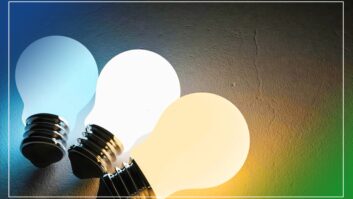Welcome to the era of solid-state lighting, featuring a variety of approaches using light-emitting diodes.
In December I shared tips about light bulbs, lumens and brightness, upon which retired TV engineer Cliff Kotchka suggested an article about how to choose the correct color temperature with the new LED lamps.
The choices are mesmerizing! These new designs have completely changed what consumers expect of household light!
LEDs offer a new palette of colors to the world of lighting. First, learn these two basic types: soft white and daylight. Soft white refers to warm golden light at 2700 Kelvin, close to the look of legacy light bulbs. Daylight emulates natural sunlight at high noon with a light blue tint at 5000 Kelvin.
What is Kelvin? Lighting designers refer to degrees of Kelvin to measure the light’s color temperature. When an old-fashioned incandescent tungsten lamp provides light, its filament heats to a temperature around 2700 Kelvin, which is about 4400 degrees Fahrenheit. Tungsten filaments are not capable of reaching more than about 3300 Kelvin or about 5500 Fahrenheit before the filament melts! Old-fashioned light bulbs are filled with helium, argon or similar inert gases to hinder filament failure at these enormous temperatures. Tungsten filaments will always provide warm orange-yellow light.

Tungsten light bulb design progressed over time. Powdery treatments inside the bulb glass gently diffused light and removed harsh shadows from light presentation. Light blue tinting resulted in successful new options for reading and emulating true daylight.
Today’s solid-state LED lighting is very efficient but presents some quizzical new challenges. Clever combinations of LED colors and passive filtering can create quite a variety of colors. Advanced designs allow fine-tuning to exact hues and lighting that can gracefully change color throughout the day, configured via smart phone apps or hand-held remote controls.
Unfortunately, we are still limited to a finite number of colors that various LED phosphors or doping can provide. Often a variety of different-colored LEDs are used to achieve a specific overall color. Some advanced designs are “tunable” using variable masking and filtering of LED elements to vary the resultant look.
One color – one ‘wattage’ LED bulbs are incredibly simple and clever in design. Just what is inside?
I was curious so I dissected a basic Sylvania 60-watt soft white LED bulb. The translucent top bulb shape was made of an easily pierced pliable plastic. I found a small circular PC board inside, complete with eight surface-mount yellow LEDs doped with an orange tint to tune the color to about 2700 Kelvin.

The little system is managed by a single miracle chip, a Bright Power Semiconductor BP5133HC. Only two additional parts were needed to complete the entire bulb: a typical 10uf/200v electrolytic capacitor and a 4.7 ohm current limiting resistor. All of this for 99 cents on sale! Amazing!
Manufacturers of LED light bulbs also must provide adequate filtering of “blue light.” Studies have shown that raw LED light includes specific blue and green light elements that can affect your sleep patterns, your skin, your eyes and your circadian rhythms.

Many current LED light bulbs already include some corrective blue light filtering. Block Blue Light is a company that embraces these concerns and takes them to the next level. Their catalog offers many alternative light sources. Are these harbingers to the future of widely marketed bulbs? See www.blockbluelight.com for a new world of ideas.
Today’s developers of advanced LED formulations yearn to concoct more accurate true-to-life light that conforms with the Color Rendering Index. Any artificial light we create needs to have little or no effect on how objects look to the human eye. Red apples need to look authentically red, not brown or bluish-grey. Bananas need to look bright yellow not grey, green or blue. Whites especially need to look white.

Look for GE’s Reveal and Sylvania’s Tru Wave Technology product lines for finer-quality LED bulbs that meet the highest standards on the color rendering index.
Important tip: When venturing into the world of solid-state LED lighting, first buy only one light bulb to test the results at home. If you enjoy what you see you can buy as many as you like with confidence. Is the light ugly or harsh to your eyes? Return the one light bulb and try again.

Be creative: Don’t be afraid to experiment with combining various color temperatures and looks. Do you have four eye-level lamps with warm light but the overall look is just a little too warm together? Try switching a light bulb or two to daylight types to bring up the overall temperature. Or add a couple more lamps fitted with daylight color bulbs. You can also experiment with how brilliant the lights are. You can certainly mix “40 watt,” “60 watt” and “100 watt” lamps to fine-tune your visual end product.
Be patient and find a bulb you like. Some “soft white” LED lamps produce a color that looks like a blend of mustard and deep orange tones, while I have seen some “brilliant white” light bulbs in action that will make your eyes weep and cry for mercy. Hand me those Ray-Bans!
Hopefully, you will eventually discover a color and intensity that are just right.












